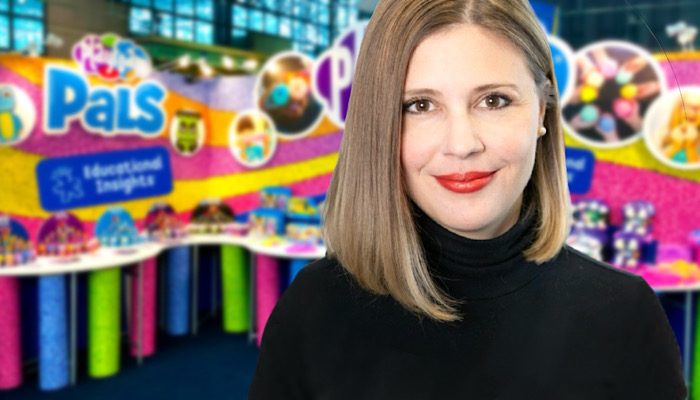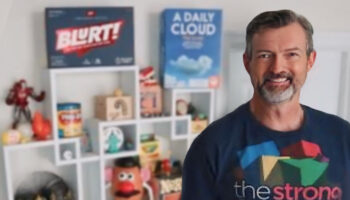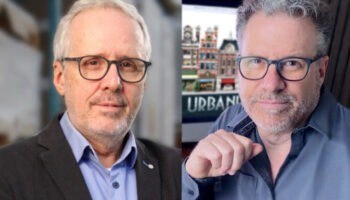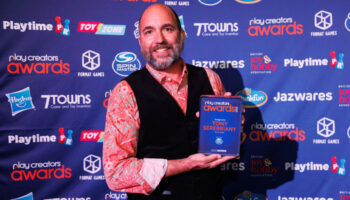Educational Insights’ Heather Weeks on inventors, creativity and misconceptions about educational toys

Based in California, Educational Insights specialises in designing award-winning toys and games that spark curiosity, build confidence and help kids embrace their originality.
Heather Weeks is the Senior Director of Product Development at Educational Insights. She has led the department since 2018 and currently oversees toy and game development for boys and girls ages two to 12 across all lines, including Playfoam, Design & Drill, Circuit Explorer, GeoSafari, Hot Dots, and more.
We caught up with Heather to find out more about the firm’s kid-first approach to design, and why she loves to work with inventors.

Hi Heather. Great to connect. First question; was toy design always on the cards? Or did you enter this industry through accidental means!
Ha! No, not quite! I would say I took a fairly circuitous path to the toy industry, though the idea was always there in the back of my mind to some degree.
I started out in film development – both studio and indie – and initially supported the latter taking a job at an educational services company, where I first learned the ropes of product development. As often happens, something that was intended to be temporary turns into anything but.
To my surprise, I enjoyed it, and so I stayed there for nearly ten years getting an education in both product development and business. I eventually set my sights on transitioning into educational toys, which is where I am today.
How would you sum up the company’s approach to design?
Well first of all, I’d give credit to the amazing talent we have here. Supporting that talent and letting people explore is definitely key.
Overall, we have a very kid-first approach to design. At Educational Insights, our mission is focused on sparking curiosity and building confidence, and one of the ways we do that is through products that are carefully crafted to provide the child with a high level of success.
‘Sparking curiosity and building confidence’ – great stuff! And yes, I can absolutely see the level of craft that goes into the range in order to achieve that.
Yes, it’s really all in the details. If you’re designing a microscope for a pre-schooler, such as our new GeoSafari Jr. KidScope, it needs to have dual eyepieces – because a child at that age has a hard time closing one eye. It also needs to work whether they are peering into it from in front or behind, and it needs to be just the right amount of magnification, so the child is excited by the detail they see – but can still make sense of the object they were originally looking at. It’s a lot of observation and fine tuning!

What’s your approach to making your products look as good as they work?
The general look of our products needs to, somewhat paradoxically, feel both fresh and evergreen. We don’t make fad toys, we’re in the business of creating things that will stand the test of time. I can’t count the number of products in our line that are 10 or 15 years old. I’m not saying that things don’t get refreshed along the way, just that it puts you into a different mindset when you’re designing.
Our team really has to be quite good at creating styles that are both current and timeless. But I would say, in some ways that epitomises the aesthetic of our brand.
Timeless, builds confidence, sparks curiosity – all vital attributes, but what would you say is the core of great Educational Insights product?
One of my colleagues, Brent Geppert, always says, “A good toy is always obvious to the child.”
Great quote!
Isn’t it?! I love it, it’s so true – they are instantly motivated to play with it. As product developers, we can do any number of things to get in the way of a good idea – overcomplicating it, designing for ourselves, designing by committee. At its heart, a good toy is simply one that engages the child, and on a deeper level, enriches them.
The perfect Educational Insights product puts a fresh spin on traditional play or takes a newer concept, like coding, and comes at it from an unexpected angle to make it more approachable for kids and parents. It goes without saying that it must also bring joy and those “eureka!” moments and be something they want to come back to again and again.

That reads like handy information for inventors, and you guys work with the inventor community. What do you enjoy about engaging with inventors?
I love working with inventors. They come to their trade via a diverse range of backgrounds and thus have these highly specialised interests and skill sets. Unlike an in-house development team, inventors have the freedom to really hone in on a problem, sometimes for years, to finetune the best solution.
We have a lot of respect for that time and effort, and we like to highlight it when we can. Educational Insights is actually known for putting inventor pictures and bios on some of our packaging. Not only do we want kids to know the people behind these great toys, but we want them to realise that game invention and toy design are real jobs that they could pursue one day.
Yes, that’s a lovely touch – and an important one! With that in mind, what should inventors be pitching to you guys?
We love pre-school games with a toyetic feature, especially something that offers good secondary play value. Brain teaser games, especially those that are portable and have a single player mode. Outdoor exploration toys, kid-friendly scientific tools – and innovative robotics that teach coding or engineering in an unexpected way!
Great – very useful! Now, designing products that are both fun and educational sounds like something of a tightrope walk. How do you tackle getting that balance right?
Well, you have to start with the fun and engaging part. I mean, if you don’t have that, you really don’t have anything… We’re not in the business of making homework after all!
If you want the child to come back to it, again and again, it’s no different than making any other toy. You have to think about the play patterns that children love and then infuse the learning within that.
I also think people generally have a misconception about educational toys. Education doesn’t have to mean dry. The entire world is new to a child and the world is a pretty exciting place.

We have a toy called the GeoSafari Jr. Talking Wildlife Camera, which takes children on an imaginative photo safari through the different biomes of our planet to discover the animals who live in them. Your personal guide is the famed teenage wildlife conservationist, Robert Irwin—I mean what’s not to love about that? I’m pretty sure I want to go on that adventure!
So, you don’t have to kill the fun to be educational, you just need to be purposeful about it, and careful that the play patterns, learning, and age target all line up.
Let’s dive into one of your recent launches – the award-winning Circuit Explorer. It looks fantastic. For anyone that hasn’t seen it, could you explain what it is and why it’s special?
Thank you so much, we’re very proud of that one.
Circuit Explorer is our new line that combines circuits with building and imaginative play for kids six and up. Each set includes three-dimensional snap-together parts with easy-to-follow markings.
Kids learn to connect power sources with conductive pieces and special components like lights, motors, and speakers to create powered vehicles and structures. Characters are also included – I mean, someone has to drive those cool vehicles! – and narrative is infused throughout.
The sets are all Mars Colony themed and prompt the child with a STEM challenge: “Welcome to Mars, Explorer! Your outpost is equipped with the supplies that you will need, your mission is to construct a rocket, a launch pad, and a rover to explore the surface…” You get the idea.
The goal was to really innovate a more engaging way to teach these popular concepts. We wanted to get kids “off the board” and immersed into an imaginative play experience. We loved the early engineering aspects of teaching circuits, but to be honest, the sets that were out there really felt like work, and we wanted this to feel like play.

It’s a fantastic idea – where did it come from?
This is one that really took a village. The initial concept came from inventor David Yakos of Streamline Design. We had approached him three or four years ago, because we were interested in getting into this space and knew that he had developed some successful circuit-based products previously.
The key for us was that we wanted something three dimensional the child could move around and play with after it was built. We also needed a strong reason for the child to take it apart again to encourage open-ended repeat play.
The prototype he initially brought to us was a series of conduit-laced flat square panels that could be connected to make a somewhat boxy, but functional toy like a helicopter with spinning rotors. In this case, the aesthetic wasn’t yet there, but the proof of concept was exactly what we needed.
So the next step was cracking how it looked?
Yes. Determining how to skin the entire thing, wrap a story around it, and turn it into a construction system – when our company had never made a construction system of that magnitude – was definitely a challenge. So, we brought in Tracy Curreri of Doodat Design, who we’d worked with in the past, and who, serendipitously, was just coming off a long stint in tech toys at another company.
Tracy really helped us, in the earliest stages, work through some of those defining decisions with research, mood boards, and a series of brainstorms. She was a fresh perspective, which can be so vital when everyone in-house is too close to an idea.
Our internal team then took over, and many, many, months and iterations later, we had what you see today. There was a lot of blood, sweat, tears – and laughs! – in this one, but I think it was worth it. At last year’s TAGIE Awards, Circuit Explorer and David Yakos were honoured for Toy Innovation of the Year, and we couldn’t be prouder.

Very well deserved too! Heather, this has been great! I’ve taken up lots of your time so I’ll just squeeze one final question in! How do you fuel your creativity?
I find that new experiences are what most fuels creativity for me. It can be visiting a new place, trying a new activity, hearing a new story. It’s hard to be inspired by sameness, whereas newness is like an adrenaline shot of ideas.
I’m also insatiably curious. I seek answers for pretty much everything that pops into my head in a given day. I simply like to understand how things work, where they came from, and how they’ve evolved. It’s a generally good trait in a product developer.
Lastly, I would say that children themselves inspire me. I have a three-year-old son and several nieces and nephews, and watching the quirky ways they play, seeing their eyes light up at something new, watching their total immersion into an imaginative world they’ve created… That moves me beyond anything and never fails to remind me that as toy developers, we need to embrace that same pure spirit of joy and wonder.
Absolutely. Well thank you so much for this Heather – looking forward to speaking again soon!
—-
To stay in the loop with the latest news, interviews and features from the world of toy and game design, sign up to our weekly newsletter here






















